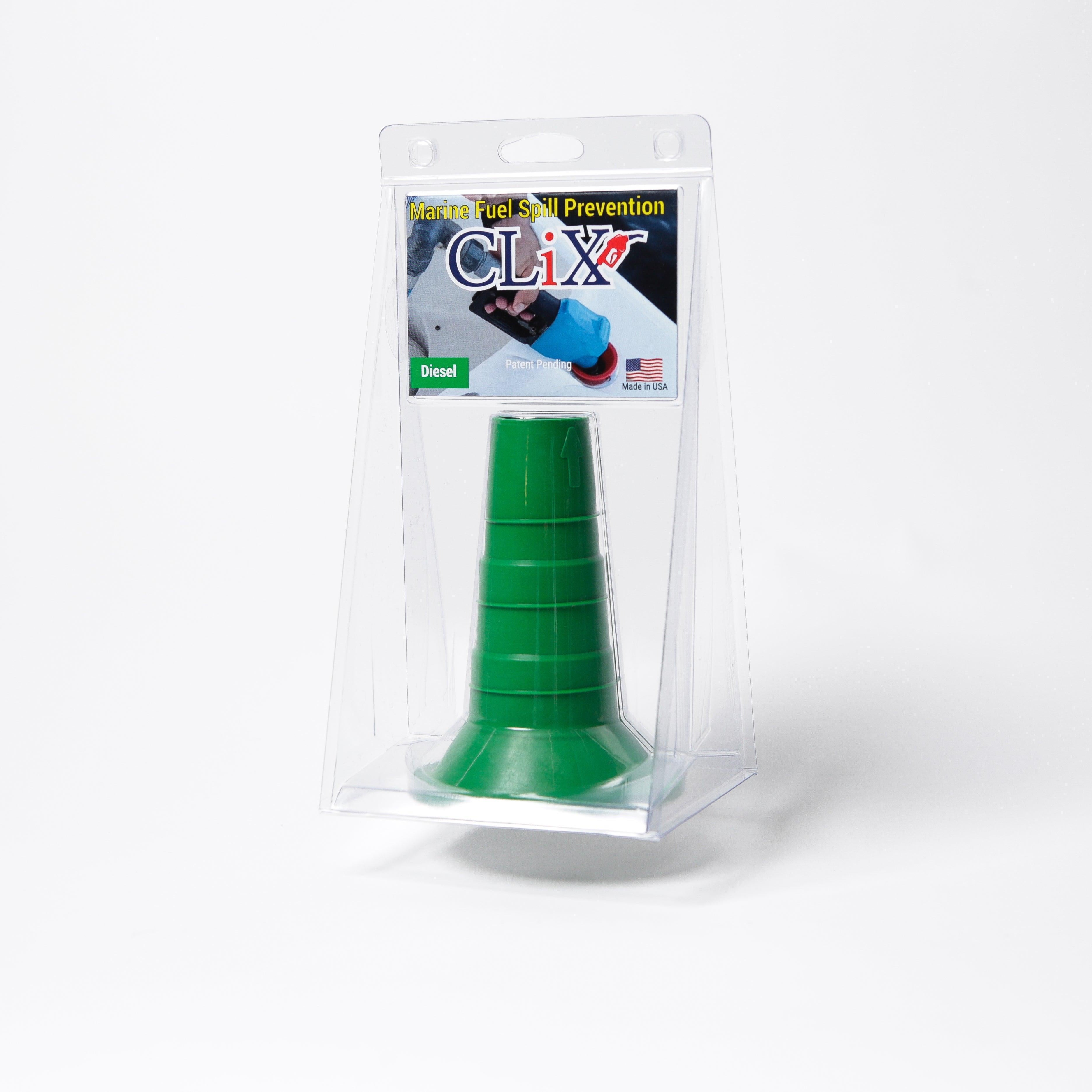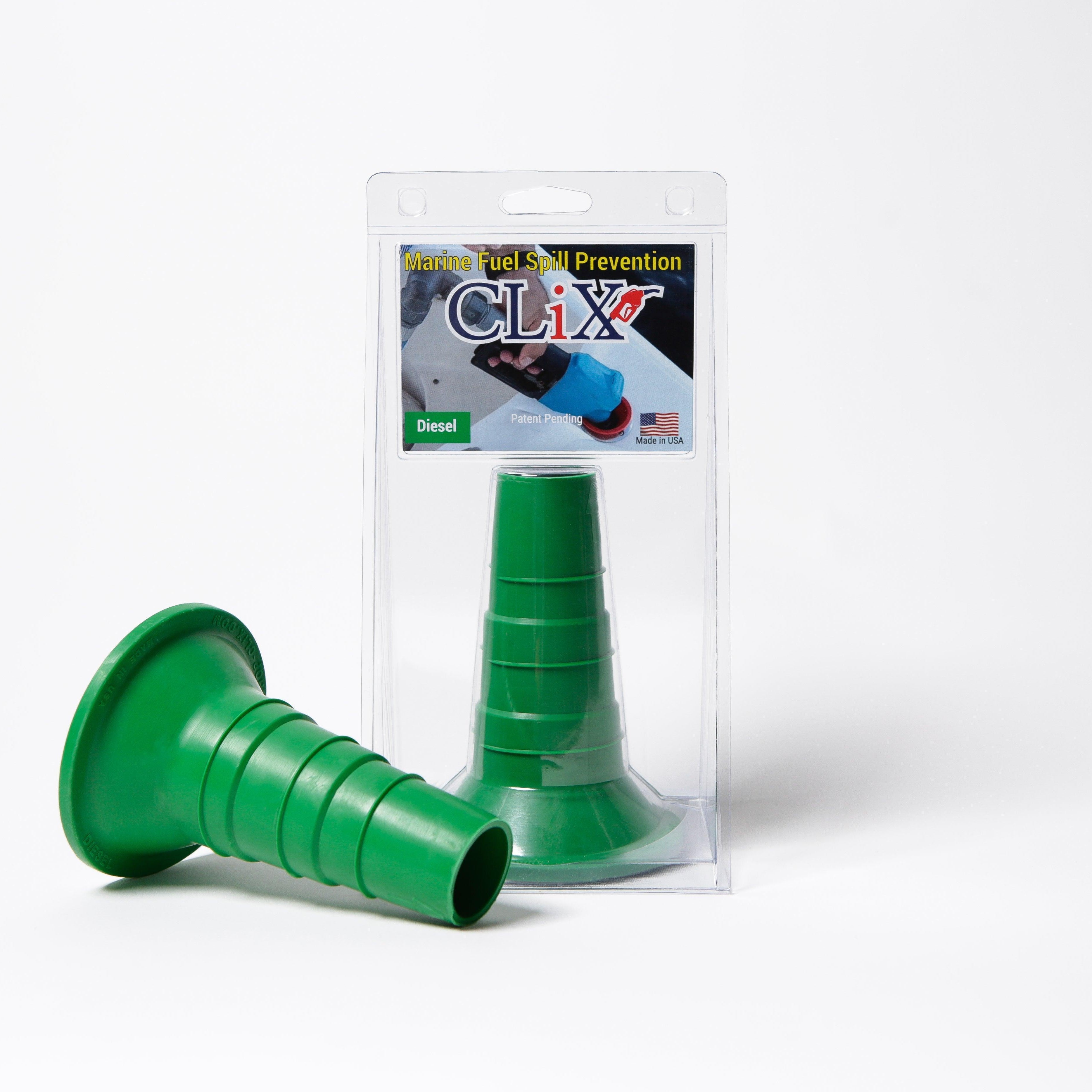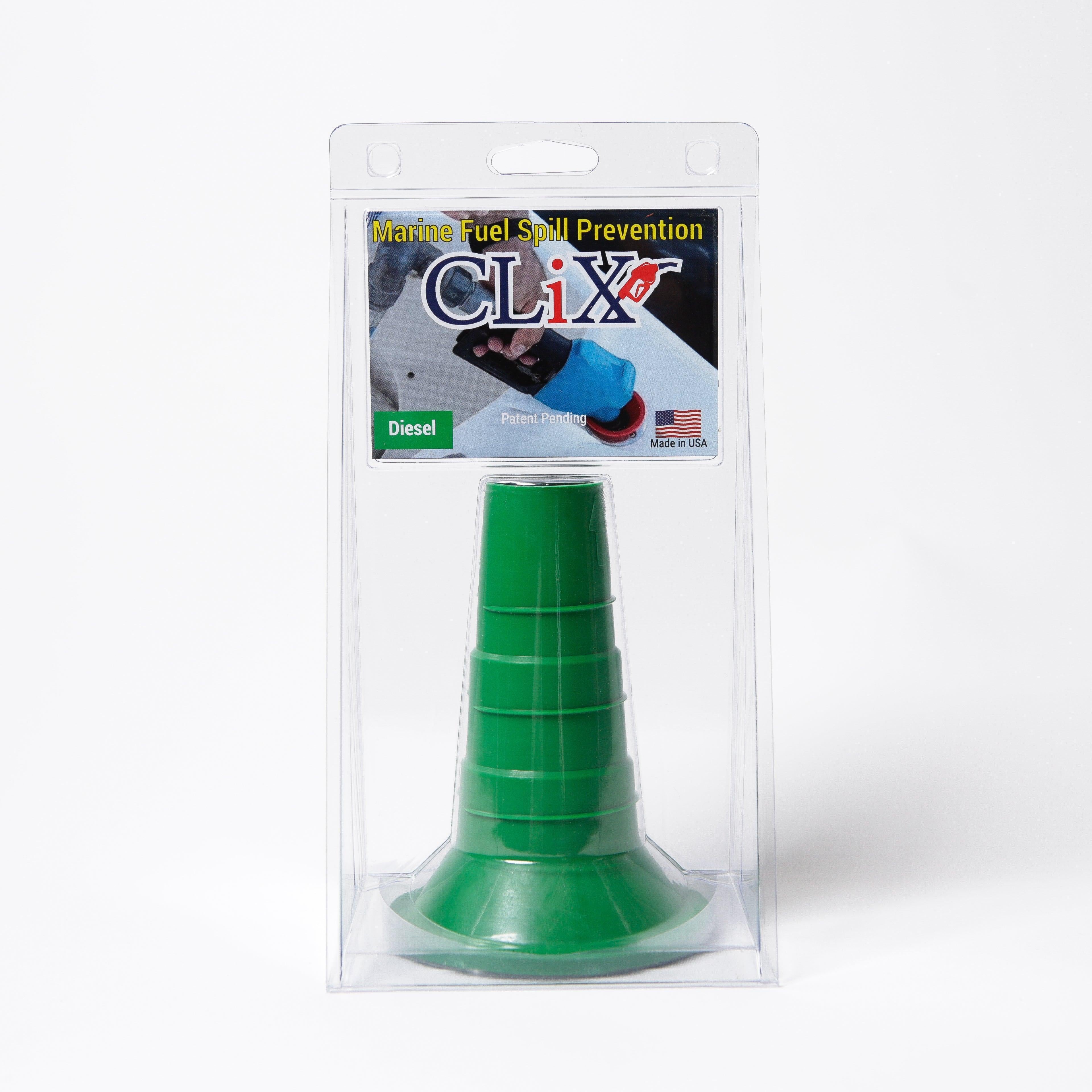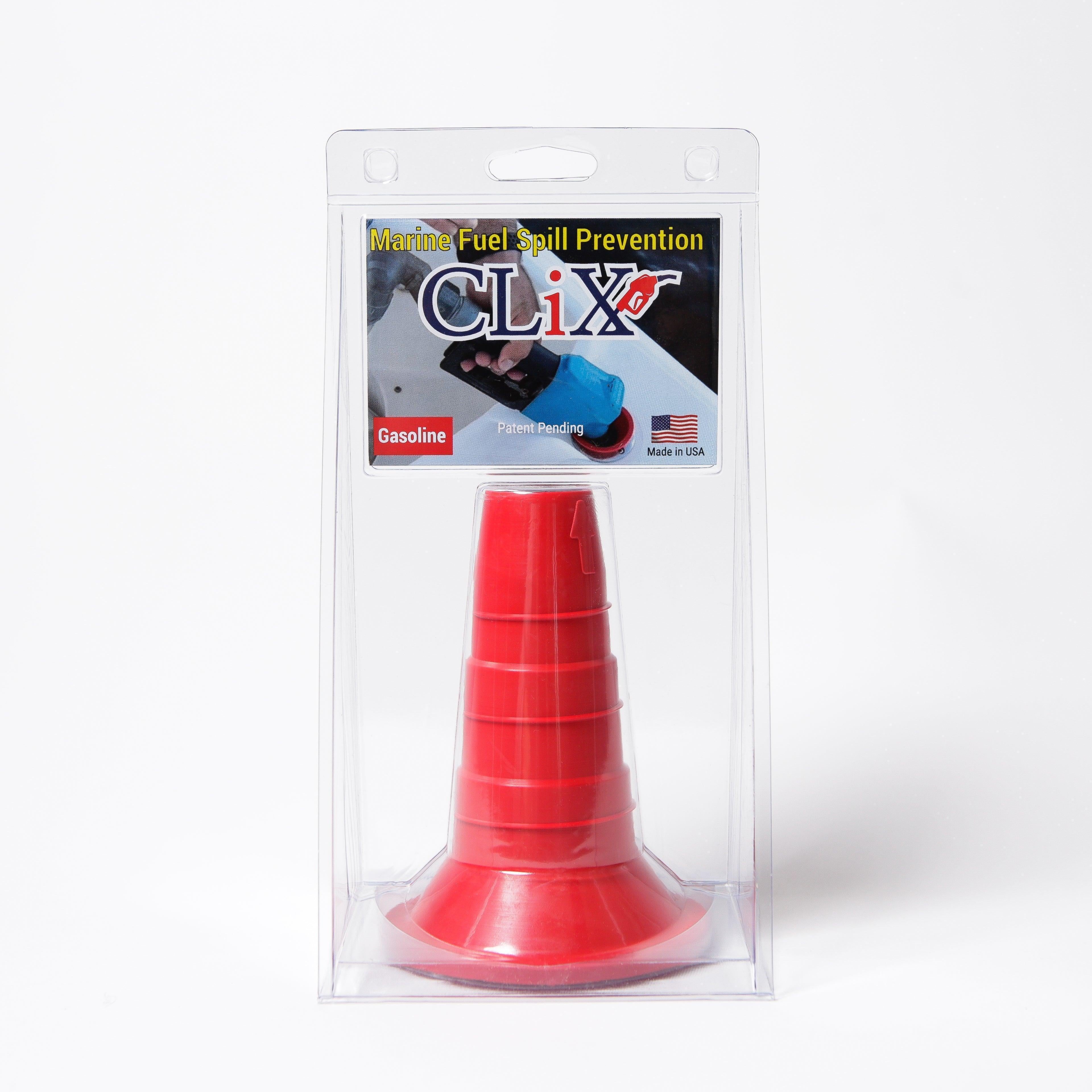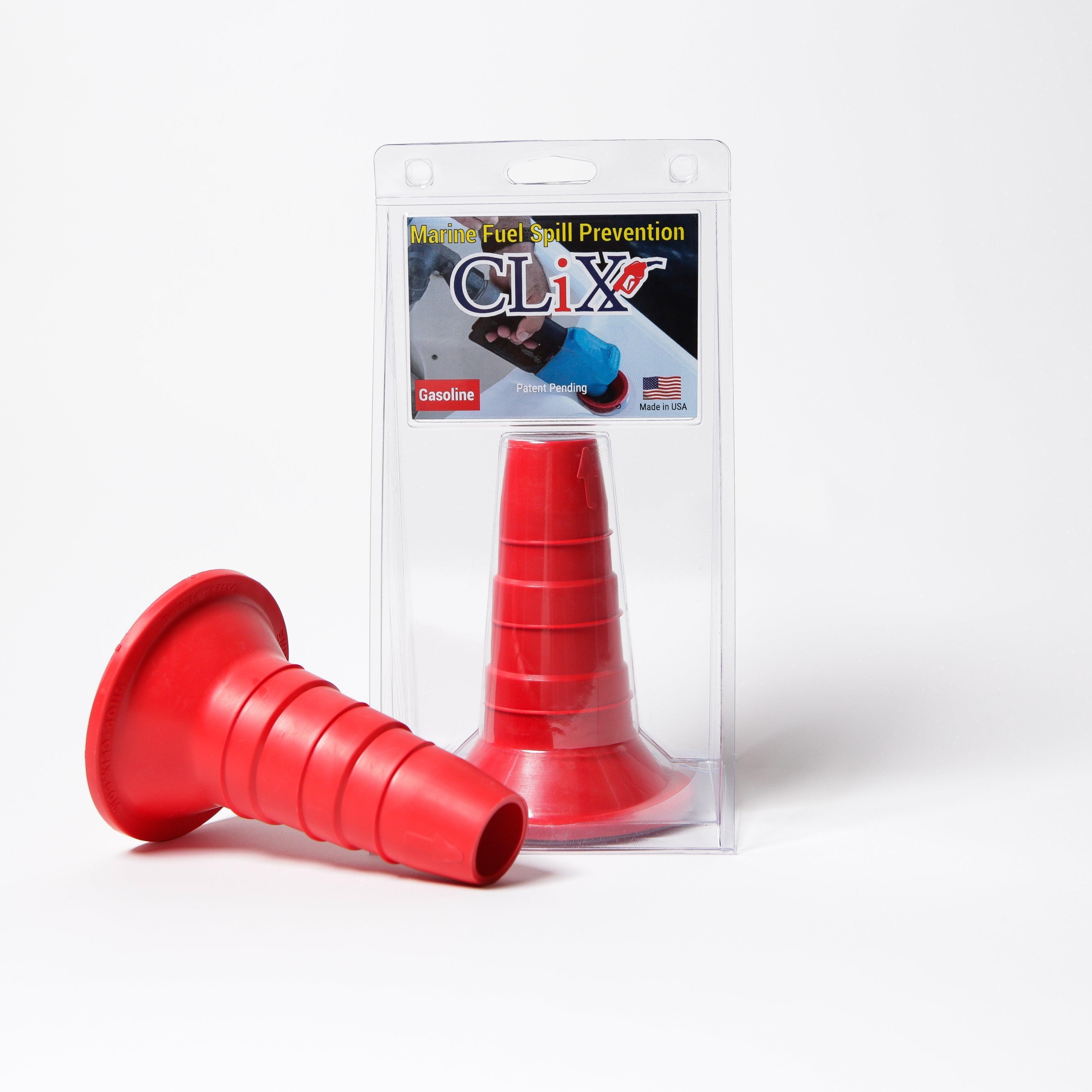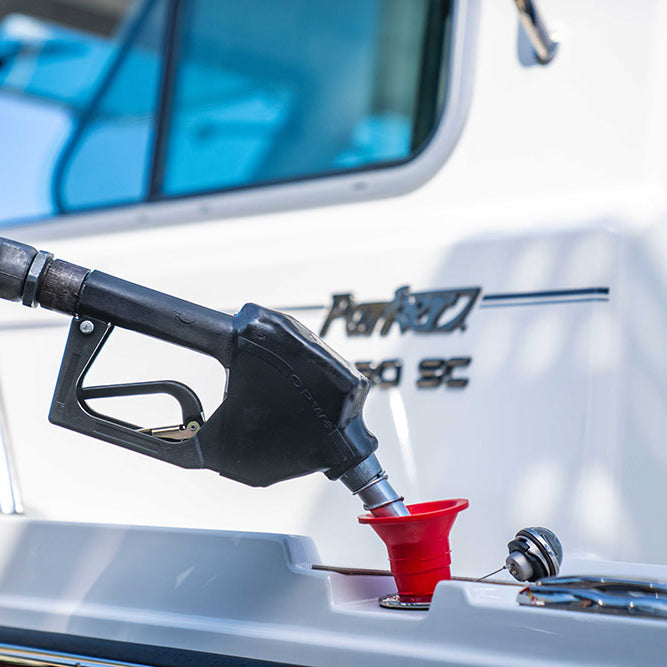At its core, a portable marine gas tank is a purpose-built container for safely storing and moving fuel on your boat. It’s made with durable materials and has specialized safety parts that you just won’t find on a standard gas can. Think of it as your lifeline for extending your time on the water, designed to handle the tough marine environment.
Why a Marine Gas Tank Is Your Most Critical Gear
It’s easy to see a portable gas tank as just a container, but it's really a critical piece of safety equipment—as vital as a life jacket or a flare gun. When you're out on the water, reliability is everything. The last place you want a problem is with your fuel system, especially when you're miles from shore.
This is exactly why a purpose-built marine tank isn't just a "nice-to-have"—it's a must for any serious boater. Unlike the red gas can you use for your lawnmower, a marine tank is engineered to handle constant motion, corrosive saltwater, and direct sunlight. It’s like comparing a simple bucket to a firefighter's helmet; one just holds water, while the other is designed for a hazardous job.
The Marine-Grade Difference
What really sets a marine gas tank apart is how it’s built and the safety features it’s required to have. These aren’t just add-ons; they're essential design elements that regulations demand to prevent a disaster.
- Durable Construction: They’re made from tough materials like high-density, UV-resistant polyethylene or corrosion-resistant metal to stop cracks and leaks from all the vibrations and bumps on the water.
- Specialized Venting Systems: Modern marine tanks have smart vents that handle changes in fuel vapor pressure from temperature swings. This stops dangerous fuel expansion or the tank from collapsing in on itself.
- Secure Fittings: These tanks come with specific connectors that lock onto your boat's fuel line for a secure, leak-proof seal—a huge step up from the simple spout on a regular can.
- Regulatory Compliance: Every certified marine tank has to meet strict standards set by the U.S. Coast Guard (USCG) and the Environmental Protection Agency (EPA) for safety and environmental protection.
Choosing a certified marine tank isn't just about following the rules; it's about buying yourself some peace of mind. It makes sure your fuel system is a source of reliability, not a potential headache, so you can actually enjoy your time on the water.
This guide will walk you through everything you need to know. We’ll cover how to pick the right material and size for your boat, go over safe fueling practices, and show you how to maintain your tank so it lasts for years. By the time you're done, you'll see why this humble piece of gear is one of the most important choices you'll make for your boat.
How to Choose the Right Gas Portable Tank
Picking the right portable gas tank for your boat is about more than just grabbing one off the shelf. It’s a crucial decision that directly affects your safety, your boat's performance, and how much time you actually get to spend enjoying the water. Think of it like choosing hiking boots—you need the right fit for the terrain you're tackling.
Your decision really comes down to two things: the tank’s material and its capacity. Let's break down what you need to know to make the right call for your specific setup.
Material Matters: Plastic vs. Metal
The first choice you’ll face is between a modern plastic tank, usually made from high-density polyethylene (HDPE), and a traditional metal one. They both hold fuel, sure, but they handle the tough marine environment in very different ways.
Plastic tanks have become the go-to for most boaters, and for good reason. HDPE is incredibly durable, handles bumps and drops without issue, and most importantly, it will never rust or corrode. That's a huge plus when you're constantly around saltwater. They’re also a lot lighter than metal tanks, which you’ll definitely appreciate when you're lugging a full tank down to the dock.
On the flip side, metal tanks—often made of steel or aluminum—are prized for their sheer ruggedness. They are tough to puncture and are less prone to permeation, which is when fuel vapors slowly escape through the tank walls. The downside? They’re heavy, and if you don't keep up with maintenance, they can fall victim to rust, especially in saltwater. This is a key reason why inspecting fuel systems in used pontoon boats is so critical before buying.
This flowchart gives you a simple way to think about it. If the fuel is for your boat, it needs to be in a proper marine-grade tank. Period.
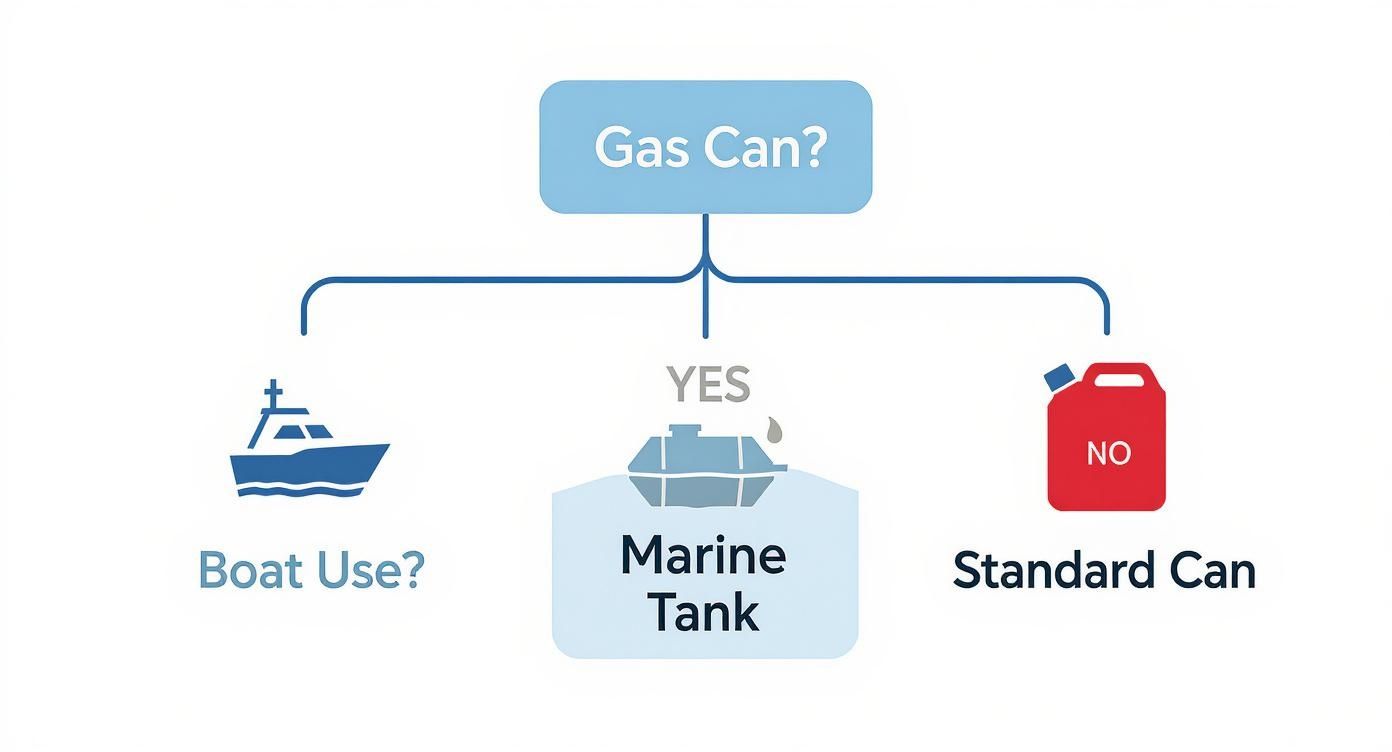
The numbers back this up. Plastic tanks make up over 55% of a global market valued at USD 2.8 billion. Boaters overwhelmingly choose them for their practicality and resistance to the elements.
To help you weigh the options, here’s a quick comparison of materials and common sizes.
Comparing Portable Gas Tank Materials and Capacities
| Feature | Plastic (HDPE) Tanks | Metal Tanks | Common Capacities & Use Cases |
|---|---|---|---|
| Durability | High impact resistance | Puncture resistant, extremely rugged | 3 Gallons: Ideal for small jon boats, inflatables, or as an emergency reserve tank. |
| Corrosion | Completely rust-proof | Prone to rust/corrosion if not maintained | 6 Gallons: The most common size, perfect for day trips in center consoles, skiffs, and pontoon boats. |
| Weight | Lightweight and easy to carry | Heavy, especially when full | 12 Gallons: Best for longer offshore runs, larger outboards, or when you need maximum range. |
| Cost | Generally more affordable | Typically more expensive |
Ultimately, both materials get the job done, but modern HDPE tanks offer a combination of safety, durability, and convenience that's hard to beat for most boaters.
Finding the Right Capacity
With the material sorted, it's time to think about size. Portable marine tanks usually come in 3-gallon, 6-gallon, or 12-gallon options. The goal is to find the sweet spot between having enough range to feel secure and not lugging around extra weight or sacrificing deck space.
To nail down the right size, ask yourself three simple questions:
- How thirsty is my engine? Check your owner's manual for its fuel consumption, often listed in gallons-per-hour (GPH). This is your baseline.
- How far do I usually go? Are you fishing in a quiet cove or heading miles offshore? Your typical trip length is the biggest factor here.
- How much room do I have? A bigger tank means more time on the water, but it also takes up space and is a beast to move when full.
A fantastic guideline to follow is the "rule of thirds" for fuel planning. Plan to use one-third of your fuel to get to your destination, one-third to get back, and keep one-third in reserve for emergencies. You never know when a storm might roll in or you decide to explore a little further.
For instance, a small boat with a 9.9 hp outboard will be perfectly happy with a 3-gallon tank for a day on the lake. But if you’re running a 19-foot center console, you’ll want at least a 6-gallon tank—maybe even a 12-gallon one—to ensure you get home safely with fuel to spare. For a closer look at specific models, check out our guide to the best portable marine fuel tank picks for 2025.
At the end of the day, choosing the right tank gives you confidence on the water. By thinking through the material and your real-world fuel needs, you can pick a tank that’s reliable, safe, and perfectly suited for your adventures.
Mastering Safe Fueling and Handling on the Water
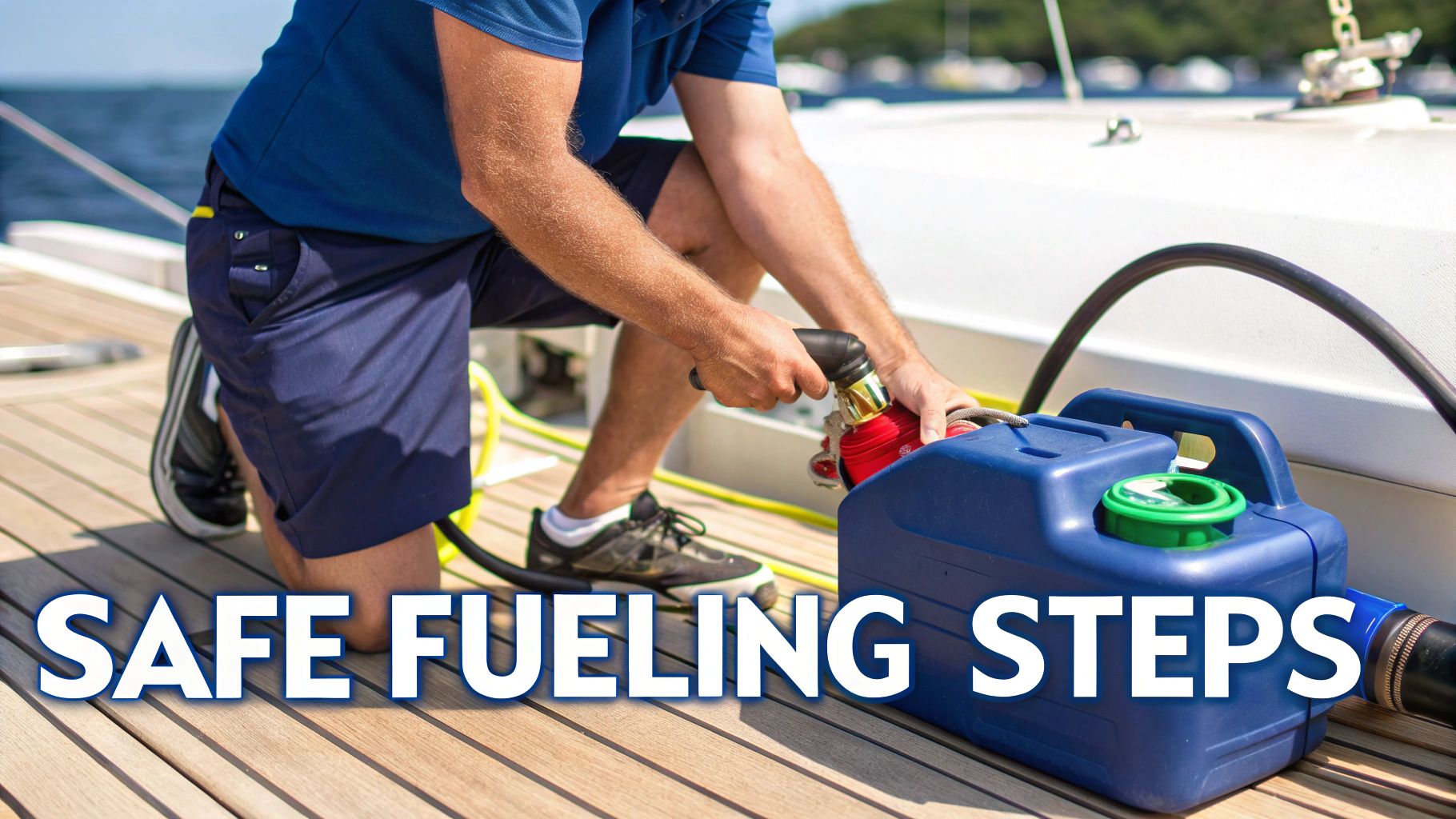
Gasoline is serious business, especially around the water where a small mistake can escalate in seconds. The single best way to stay safe is to develop a simple, repeatable fueling routine. This isn't about being paranoid; it's about making smart habits second nature.
Think of it like a pilot's pre-flight checklist. It's a non-negotiable process you follow every single time. Considering the risks of a fuel spill or, even worse, a fire, there's just no good reason to ever cut corners.
Your Pre-Fueling Safety Checklist
Before a single drop of fuel enters the tank, a quick look-over can catch a disaster before it happens. This takes less than a minute but buys you a whole lot of peace of mind.
-
Inspect the Tank and Hoses: Give your gas portable tank a thorough once-over. Are there any cracks, deep gouges, or that chalky, faded look that signals UV damage? Check the fuel line for cracking or brittleness and make sure every connection is snug.
-
Check Seals and Gaskets: The O-rings and gaskets on your fuel cap and connectors are your primary defense against leaks. They should be pliable, not cracked or dried out. A bad seal is an open invitation for dangerous vapors to escape.
-
Extinguish All Flames: This is the golden rule, and it’s not flexible. Make absolutely sure all cigarettes, grills, or any other open flames are completely out. Kill the engine, generator, and even the galley stove before you start.
The Correct Fueling Procedure
Where and how you fill your tank is just as critical as the inspection. Whenever possible, fill your portable tanks on land, far away from the boat and the water. This makes managing a potential spill much, much easier.
The cardinal rule of fueling: Always place the tank on the ground before you start filling. Never, ever fill a portable tank while it's in your car, on the boat deck, or sitting in a truck bed. This simple step is vital for grounding the tank and preventing a static spark from igniting gas fumes.
A step-by-step approach takes the guesswork out of the process and keeps you safe.
- Choose a Well-Ventilated Area: Gas fumes are heavier than air and will pool in low spots. Always fuel up in an open area to let those fumes blow away harmlessly.
- Maintain Contact: Keep the pump nozzle touching the tank’s fill opening the entire time. This physical contact helps dissipate any static electricity that can build up as fuel flows.
- Fill Slowly and Carefully: Don’t rush it. A slow, steady stream prevents splashing. Aim to fill the tank to no more than 95% capacity. That extra space is crucial to allow for fuel expansion on a hot day. For a complete rundown on marine facilities, check out this helpful guide to boat fuel stations and safety tips.
Onboard Fueling and Handling
If you absolutely have to refuel on the water, the stakes are higher. You need to be extra cautious.
First, get all passengers off the boat. If you're at a dock, make sure the boat is tied up securely. When you're pouring from the portable can into your boat's main tank, use a proper funnel or a spill-proof siphon to keep fuel from ending up in the water. For more on this, our guide explains in detail where and how to fill your portable gas tanks safely.
After you're done, wipe up any spills immediately with an absorbent rag. Don't just toss it overboard! Store it in a sealed container and dispose of it properly back on shore. Before you even think about starting the engine, open all the hatches and run your bilge blower for at least four minutes to clear out any stray vapors.
Last but not least, do the "sniff test." If you smell even a hint of gasoline, find the source and fix it before turning the key.
Upgrading to Modern Spill-Proof Fueling Systems
Every boater knows that sickening feeling of a fuel spill. It’s a messy, dangerous mistake that harms marine life and can leave you with a hefty cleanup bill and fines. For the longest time, our only defense was a sharp eye and a quick hand on the fuel nozzle, but let's be honest—distractions happen.
Thankfully, technology has finally caught up. Think of it like a smart water bottle that knows exactly when to say "when." Modern spill-proof fueling systems bring that same automatic shut-off magic to your boat's gas portable tank and onboard system, taking the guesswork and human error completely out of the equation.
The Problem with the Old Way of Fueling
Refueling the traditional way is an imprecise art. You're either listening for that gurgle that signals the tank is almost full or nervously watching a fuel gauge that might not be perfectly accurate. It only takes a second of looking away for gasoline to spew from the vent, staining your deck, polluting the water, and creating a serious fire hazard.
A single pint of spilled fuel can create a slick on the water's surface the size of an acre. Preventing these spills isn't just about avoiding a mess; it's a critical part of being a responsible boater and protecting the fragile ecosystems we all love.
This is where dedicated spill-prevention tech changes the game. By creating a closed-loop system, these devices automatically cut the flow the second your tank hits its safe capacity. You get total peace of mind, knowing an overfill is virtually impossible.
How Spill-Proof Systems Work
The idea behind these systems is brilliantly simple and effective. It all comes down to a special fitting on the boat’s fuel tank that "talks" to a compatible fuel nozzle. As the tank fills, back pressure builds up and trips an automatic shut-off mechanism in the nozzle—just like the pump at your local gas station.
Here’s why that matters:
- No More Overfills: The system automatically stops the fuel flow when the tank is full, eliminating the number one cause of spills.
- Fewer Fumes: The sealed connection keeps harmful gasoline vapors from escaping into the air.
- Saves You Money: You stop wasting expensive fuel, so these systems eventually pay for themselves.
- Keeps You Compliant: It helps you meet environmental regulations and dodge potential fines for fuel spills.
This technology is becoming the new standard as boaters look for safer, cleaner ways to enjoy the water. The entire portable fuel tank market is growing, and even niche areas are seeing big gains. The collapsible fuel tank market, for example, is projected to expand by 8.8% each year as more people look for convenient storage options. You can find more details about this growing market on OpenPR.com.
If you want to get into the nuts and bolts, our guide on automatic fuel nozzle systems offers a complete breakdown of how the technology works.
The CLiX Fueling Solution
A great example of this tech in action is the CLiX Fueling Solutions system. It's a clean, reliable way to upgrade your boat’s fueling setup. When you install the CLiX unit, you create a perfect seal between the nozzle and your tank, guaranteeing a spill-free fill every single time.
Making the switch is a simple modification that delivers huge benefits. It turns fueling from a tense, watch-every-second chore into a relaxed, worry-free routine. This small change makes a big difference for your safety, your boat, and the waters we all share.
Proper Maintenance and Storage for Your Gas Tank
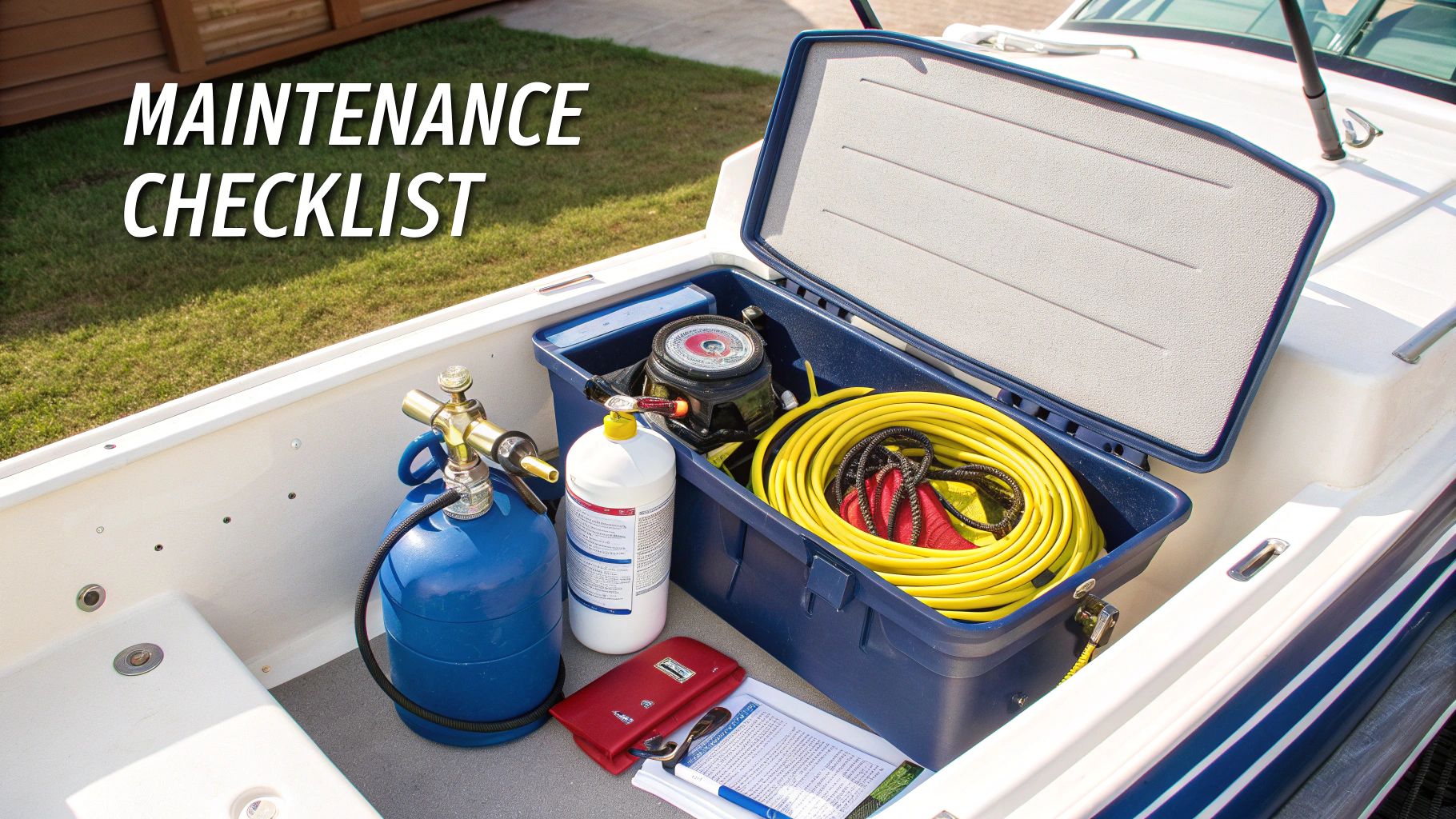
A portable gas tank is a real workhorse, but like any crucial piece of boating gear, it needs a little TLC to keep doing its job safely. Think of it this way: spending a few minutes on maintenance is a small price to pay to avoid a dead engine, expensive repairs, or contaminated fuel when you're miles from shore.
A simple routine for regular care and off-season storage will keep your tank in top shape for years. These steps are easy, and they make sure your fuel system is something you can count on, not something you have to worry about.
Your Routine Maintenance Checklist
Before you head out, get in the habit of doing a quick visual check. It only takes a minute and can save you a world of hurt by catching small problems before they turn into big ones.
- Look for Damage: Give the tank a once-over. Are there any cracks, deep scratches, or a chalky look to the plastic? That's a sign of UV damage. If you have a metal tank, keep an eye out for rust spots or major dents that could weaken it.
- Check Hoses and Seals: Give the fuel line a gentle squeeze. It should feel flexible, not hard or brittle. Take a look at the gaskets on the fuel cap and connectors—they should be soft and create a solid seal to keep vapors from escaping.
- Clear the Vent: Make sure the tank’s vent isn’t clogged with dirt or debris. A blocked vent can cause the tank to swell up or even collapse from pressure changes, which messes with fuel flow and can create dangerous leaks.
This need for reliable, portable fuel is a big deal. In fact, the global portable butane gas tank market is expected to jump from USD 750 million to over USD 1.2 billion by 2033, thanks to its popularity in recreation and travel. You can discover more insights about the portable tank market and its rapid growth.
Preparing for Off-Season Storage
What you do with your gas portable tank during the off-season is just as critical as your pre-launch checks. You really have two choices: store it with treated fuel or store it bone-dry. The best method depends on your setup and where you'll be keeping it.
Storing your tank properly is all about defeating the two biggest enemies of any boat engine: water contamination and fuel going bad. Old, untreated gas can turn into a sticky varnish that gums up fuel lines and carburetors, leaving you with a motor that won't start on that first beautiful day of the season.
Option 1: Storing with Stabilized Fuel
If you decide to leave gas in the tank, you've got to do it right. This prevents moisture from getting in and keeps the fuel fresh until you're ready to hit the water again.
- Add a Fuel Stabilizer: Grab a quality marine-grade stabilizer and add it to the tank. Just follow the instructions on the bottle for the right ratio.
- Fill It Up (Almost): Top off the tank until it's about 95% full. Leaving a little room for expansion is key, but filling it this much reduces the air space where condensation can form.
- Run the Engine: If you can, hook the tank up and run the engine for a few minutes. This pulls the stabilized fuel all the way through the system, protecting the engine's internal parts, too.
- Find a Safe Spot: Store the tank in a well-ventilated area, far away from any ignition sources like a furnace, pilot light, or water heater. A spot with a steady temperature is ideal to keep the fuel from expanding and contracting too much.
Navigating Fuel Tank Rules and Regulations
Marine fuel regulations can feel like a tangled net of acronyms, but they all boil down to one thing: keeping you, your passengers, and the water safe. Getting a handle on the basics isn't just about avoiding a fine; it’s about making sure your gear can safely manage gasoline in a constantly moving environment.
In the United States, the two big players are the U.S. Coast Guard (USCG) and the Environmental Protection Agency (EPA). A simple way to think about it is that the USCG is focused on operational safety—preventing fires and explosions—while the EPA is all about environmental protection, specifically controlling fuel vapor emissions. Together, their rules shape exactly how a marine gas portable tank has to be built and used.
Understanding Key Certifications
When you pick up a marine fuel tank, you're not just buying a plastic jug. You're buying a piece of certified safety equipment. Any portable tank sold in the U.S. has to meet a strict set of design standards. The first thing you should always look for is the manufacturer's label, which needs to state clearly that it complies with USCG and EPA rules.
This certification is your guarantee that the tank has been put through some serious testing for things like:
- Pressure and Leak Resistance: It can handle pressure changes from temperature swings without leaking a drop.
- Slosh and Drop Testing: It's tough enough to survive being dropped or shaken around without cracking.
- Fire Resistance: The materials won't easily ignite and can resist a fire for a set amount of time.
A tank without these certifications isn't just illegal for your boat; it's a genuine hazard. It simply doesn't have the heavy-duty construction needed for life on the water, creating a real risk of fuel spills and fires.
Modern Venting Systems Explained
One of the biggest shifts in regulations over the last several years has been in fuel venting. You might remember older tanks with that little manual vent screw on the cap. To cut down on air pollution from evaporating gas, the EPA mandated all-new designs for every gas portable tank.
Today's tanks have automatic, carbon-filtered vents that manage vapor release for you. That means you no longer have to remember to open a vent before starting the engine. The system is designed to "breathe" on its own, safely letting out pressure while trapping the harmful fumes. This is why you'll sometimes see modern tanks swell a bit in the sun—it's a normal sign that the tank is doing its job managing internal pressure.
Finally, don't forget that securing your tank is also a rule. It has to be tied down firmly so it can't slide around or tip over. Using proper hold-down straps or a designated tank tray is non-negotiable. An unsecured tank is more than just a bad idea; it’s a violation waiting to happen if you're stopped for a routine safety check.
Got Questions About Your Portable Gas Tank?
Even the most seasoned boaters run into questions about their gear, and fuel tanks are no exception. Getting a straight answer can be the difference between a great day on the water and a frustrating one. We’ve pulled together some of the most common questions we hear to help you get things sorted out quickly.
Think of this as your personal troubleshooting cheat sheet. Whether you're wondering when to retire an old tank or need a quick refresher on safety rules, you'll find what you need right here.
How Often Should I Replace My Portable Gas Tank?
There isn't a hard-and-fast expiration date, but you absolutely should replace your tank at the first sign of real wear and tear. For plastic tanks, keep an eye out for deep scratches, cracks, or a chalky, faded look—that’s a clear sign of UV damage. If you have a metal tank, any rust, leaks along the seams, or major dents mean its service life is over.
As a general rule of thumb, plan on replacing a plastic marine tank every 5-10 years. No matter how good the UV inhibitors are, sun and exposure will eventually make the plastic brittle and prone to cracking.
Don't forget about the seals and gaskets on the cap and fuel connector. They're just as critical as the tank itself. If they look cracked, feel hard, or aren't flexible anymore, it's time for a new tank. A bad seal is one of the most common causes of dangerous vapor leaks.
Can I Just Use a Regular Red Gas Can on My Boat?
No, you absolutely cannot. Using a standard automotive gas can on a boat is not only unsafe but, in most places, it's also illegal. Marine-specific tanks are built to tough U.S. Coast Guard (USCG) and EPA standards for very good reasons.
- Built to Last: They're constructed to handle the constant vibration, slamming, and corrosive saltwater environment that would destroy a normal can.
- Smarter Vents: Marine tanks have special safety vents designed to handle pressure changes without spewing flammable fumes into a confined space like a boat bilge.
- Secure Connections: They use specific fittings that lock onto your boat’s fuel line, creating a seal that won’t leak or pop off.
Using a regular can is a serious fire risk and can get you a hefty fine if you're boarded for a safety inspection. It's just not worth it.
What's the Best Way to Secure a Tank on My Boat?
Your best bet is to use a dedicated hold-down tray made for your tank's size, or at the very least, heavy-duty straps with solid buckles. Never, ever use bungee cords. They can stretch or snap in rough seas, turning your full gas tank into a dangerous projectile.
Make sure you anchor the tank tightly to a solid part of the boat. It should be in a well-ventilated spot, far away from batteries, wiring, or any other heat sources. An unsecured tank sliding around is just an accident waiting to happen.
For the Off-Season, Should I Store My Tank Full or Empty?
You can do it either way, but you have to do it right. If you're storing it with fuel, add a good marine fuel stabilizer, fill the tank to about 95% full to leave a little room for expansion, and seal the cap tightly. This minimizes air space, which helps prevent condensation from forming inside.
If you'd rather store it empty, be sure to drain every last drop. You'll then need to take that old gas to an approved hazardous waste collection site for proper disposal. The one thing you should never do is let untreated gas sit in a tank for more than a month or two—it'll break down and leave a gummy mess that will wreak havoc on your engine.
Stop worrying about fuel spills and overfills forever. CLiX Fueling Solutions offers a simple, automatic system that guarantees a perfect fill every time, protecting your boat and the environment. Upgrade your fueling experience by visiting https://clixfueling.com.

